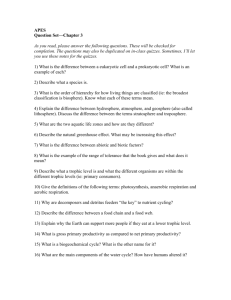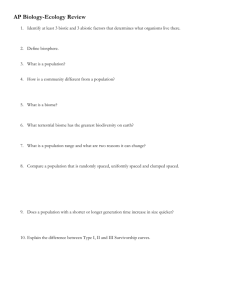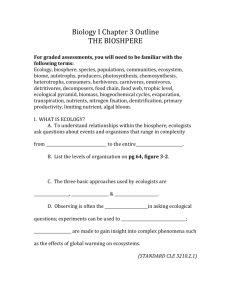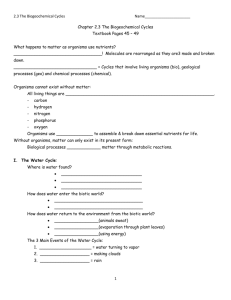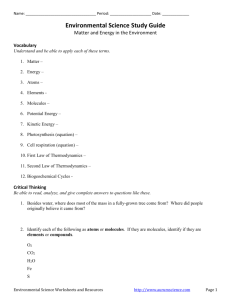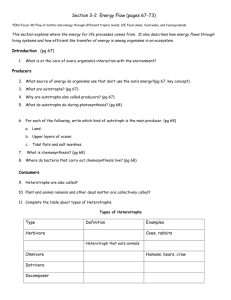Lecture Presentation to accompany Principles of Life
advertisement
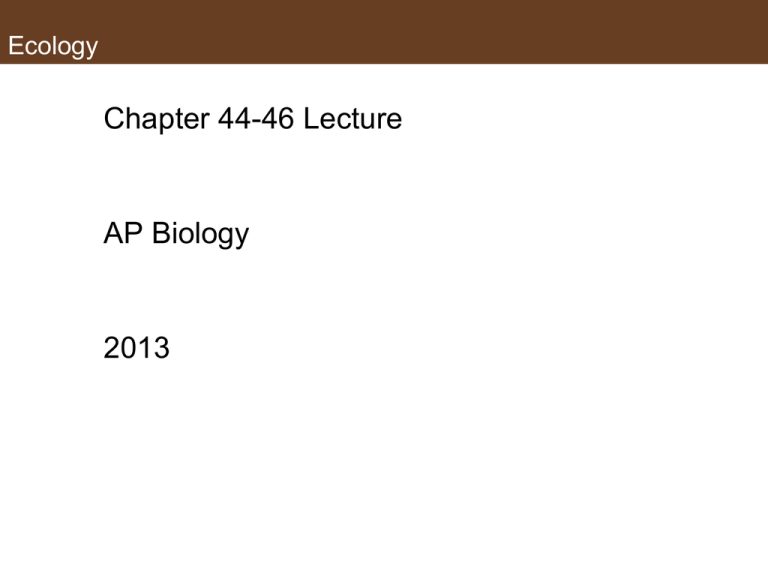
Ecology Chapter 44-46 Lecture AP Biology 2013 44 Ecological and Evolutionary Consequences of Species Interactions Concept 44.1 Interactions between Species May Be Positive, Negative, or Neutral Interspecific interactions (between individuals of different species) affect population densities, species distributions, and ultimately lead to evolutionary changes. The interactions can be beneficial or detrimental to either of the species. Figure 44.1 Types of Interspecific Interactions (Part 1) Concept 44.1 Interactions between Species May Be Positive, Negative, or Neutral Interspecific competition refers to –/– interactions Members of two or more species use the same resource. At any one time there is often one limiting resource in the shortest supply relative to demand. Figure 44.1 Types of Interspecific Interactions (Part 2) Green plants compete for light. The leaves of tall trees have reduced light available to the plants growing on the forest floor. Concept 44.1 Interactions between Species May Be Positive, Negative, or Neutral Consumer–resource interactions—organisms get their nutrition by eating other living organisms. +/– interactions—the consumer benefits while the consumed organism loses Includes predation, herbivory, and parasitism. Kills and consumes individuals of another species Animal consumes part of or all of a plant A parasitic organism consumes part of a host individual but usually does not kill it Figure 44.1 Types of Interspecific Interactions (Part 3) Concept 44.1 Interactions between Species May Be Positive, Negative, or Neutral Mutualism benefits both species: +/+ interaction Examples: • Leaf-cutter ants and the fungi they cultivate • Plants and pollinating or seed-dispersing animals • Humans and bifidobacteria in our guts • Plants and mycorrhizal fungi • Lichens • Corals and dinoflagellates Figure 44.1 Types of Interspecific Interactions (Part 4) Concept 44.1 Interactions between Species May Be Positive, Negative, or Neutral Commensalism—one species benefits while the other is unaffected (+/0 interaction). • Brown-headed cowbird follows grazing cattle and bison, foraging on insects flushed from the vegetation. • Cattle convert plants into dung, which dung beetles can use. Dung beetles disperse other dung-living organisms such as mites and nematodes, which attach themselves to the bodies of the beetles. Concept 44.1 Interactions between Species May Be Positive, Negative, or Neutral Amensalism—one species is harmed while the other is unaffected (–/0 interactions). Tend to be more accidental than other relationships. Example: a herd of elephants that crush plants and insects while moving through a forest. Concept 44.1 Interactions between Species May Be Positive, Negative, or Neutral Relationships between species do not always fit perfectly into these categories. Fish that live with sea anemones escape predation by hiding in the anemone tentacles. Effects of this on the anemones is unclear. Do the fish steal some of their prey? Do they get nutrients from fish feces? It may depend on the availability of nutrients. Concept 44.2 Interspecific Interactions Affect Population Dynamics and Species Distributions Density-dependent population growth reflects intraspecific (within-species) interactions among individuals in a population. They are usually detrimental because per capita resource availability decreases as population density increases. Concept 44.2 Interspecific Interactions Affect Population Dynamics and Species Distributions Resource partitioning—different ways of using a resource. Example: Paramecium caudatum can coexist with P. bursaria. P. bursaria can feed on bacteria in the lowoxygen sediment layer at the bottom of culture flasks. P. bursaria has symbiotic algae that provides it with oxygen from photosynthesis. Figure 44.5 Resource Partitioning Can Result in Intraspecific Competition Being Greater than Interspecific Competition Leaf Cutting Ants and Fungi Watch. Can you explain their mutualistic existence? Answer to Opening Question In the mutualism between leaf-cutter ants and the fungus they cultivate, both species gain nutrition from the interaction. Ants also disperse the fungus and protect it from pathogens. It may have started when ants began eating the fungi growing on refuse in their nests. Ants that provided better growing conditions had more fungus to eat and thus higher fitness. Answer to Opening Question Fungi that provided ants with more nutrients were more likely to be propagated by ants. The ants expanded their food base by feeding leaves to the fungi (ants can’t digest the leaves). The fungi then had access to food they would not be able to use if ants did not chop it up for them. Figure 44.11 A Fungal Garden Answer to Opening Question Leaf-cutter ants and their fungi have been very successful: They are major herbivores in the Neotropics, and have expanded into dry environments that are normally hostile to fungi. 45 Ecological Communities Concept 45.1 Communities Contain Species That Colonize and Persist Community—a group of species that coexist and interact with one another within a defined area Biologists may designate community boundaries based on natural boundaries (e.g., the edge of a pond) or arbitrarily. They may restrict study to certain groups (e.g., the bird community). Concept 45.1 Communities Contain Species That Colonize and Persist Communities are characterized by species composition; that is, which species they contain and the relative abundances of those species. A species can occur in a location only if it is able to colonize and persist there. A community contains those species that have colonized minus those that have gone extinct locally. Concept 45.1 Communities Contain Species That Colonize and Persist Local extinctions can occur for many reasons: • Species unable to tolerate local conditions • A resource may be lacking • Exclusion by competitors, predators, or pathogens • Population size too small; no reproduction Concept 45.1 Communities Contain Species That Colonize and Persist In 1883 the volcano on Krakatau erupted, killing everything on the island. Scientists studied the return of living organisms. Within 3 years, seeds of 24 plant species had reached the island. Later, as trees grew up, some pioneering plant species that require high light levels disappeared from the island’s now-shady interior. Species composition continues to change as new species colonize and others go extinct. Figure 45.1 Vegetation Recolonized Krakatau (Part 1) Concept 45.2 Communities Change over Space and Time Species often replace one another in a predictable sequence called succession. Concept 45.3 Trophic Interactions Determine How Energy and Materials Move through Communities Each species in a community has a unique niche. This concept refers to the environmental tolerances of a species, which define where it can live. Also refers to the ways a species obtains energy and materials and to patterns of interaction with other species in the community. Concept 45.3 Trophic Interactions Determine How Energy and Materials Move through Communities Consumer–resource, or trophic interactions cause energy and materials to flow through a community. Trophic levels—feeding positions Primary producers, or autotrophs, convert solar energy into a form that can be used by the rest of the community. Concept 45.3 Trophic Interactions Determine How Energy and Materials Move through Communities Heterotrophs get energy by breaking apart organic compounds that were assembled by other organisms. Primary consumers (herbivores) eat primary producers. Secondary consumers (carnivores) eat herbivores. Tertiary consumers eat secondary consumers. Concept 45.3 Trophic Interactions Determine How Energy and Materials Move through Communities Omnivores feed from multiple trophic levels. Decomposers, or detritivores, feed on waste products or dead bodies of organisms. Decomposers are responsible for recycling of materials; they break down organic matter into inorganic components that primary producers can absorb. Concept 45.3 Trophic Interactions Determine How Energy and Materials Move through Communities Trophic interactions are shown in diagrams called food webs. Arrows indicate the flow of energy and materials —who eats whom. Figure 45.6 A Food Web in the Yellowstone Grasslands Concept 45.3 Trophic Interactions Determine How Energy and Materials Move through Communities Gross primary productivity (GPP)—total amount of energy that primary producers convert to chemical energy. Net primary productivity (NPP)—energy contained in tissues of primary producers and is available for consumption. Change in biomass of primary producers (dry mass) per unit of time is an approximation for NPP. Concept 45.3 Trophic Interactions Determine How Energy and Materials Move through Communities Ecological efficiency is about 10%: Only about 10% of the energy in biomass at one trophic level is incorporated into the biomass of the next trophic level. This loss of available energy at successive levels limits the number trophic levels in a community. Concept 45.3 Trophic Interactions Determine How Energy and Materials Move through Communities Ecological efficiency is low because: • Not all the biomass at one trophic level is ingested by the next one. • Some ingested matter is indigestible and is excreted as waste. • Organisms use much of the energy they assimilate to fuel their own metabolism. Concept 45.4 Species Diversity Affects Community Function Species diversity has two components: Species richness—the number of species in the community. Species evenness—the distribution of species’ abundances Figure 45.9 Species Richness and Species Evenness Contribute to Diversity Less diverse than B because it contains 3 equally abundant species rather than 4 Most Diverse! Less diverse than B because it has an uneven distribution of the 4 species 46 The Global Ecosystem Concept 46.1 Climate and Nutrients Affect Ecosystem Function Ecosystem—an ecological community plus the abiotic environment with which it exchanges energy and materials. Ecosystems are linked by processes and material movements. Concept 46.2 Biological, Geological, and Chemical Processes Move Materials through Ecosystems All the materials in the bodies of living organisms are ultimately derived from abiotic sources. Primary producers take up elements from inorganic pools and accumulate them as biomass. Trophic interactions pass the elements on to heterotrophs. Decomposers break down the dead and waste matter pool into elements that are available again for uptake by primary producers. 4 Biogeochemical Cycles Water Cycle Nitrogen Cycle Carbon Cycle Phosphorus Cycle WATER CYCLE The global water (hydrological) cycle: Water is essential for life; makes up 70% of living biomass. Flowing water is an erosion agent and transports sediment—moves material around the planet. Because of high heat capacity, water redistributes heat as it circulates through the oceans and atmosphere. Figure 46.6 The Global Water Cycle Concept 46.3 Certain Biogeochemical Cycles Are Especially Critical for Ecosystems Solar-powered evaporation moves water from ocean and land surfaces into the atmosphere. The energy is released again as heat when water vapor condenses. WATER CYCLE Humans affect the water cycle by changing land use: • Reduced vegetation (deforestation, cultivation, etc.) reduces precipitation retained in soil and increases amount that runs off. • Groundwater pumping depletes aquifers, brings water to surface where it evaporates. • Climate warming will melt ice caps and glaciers and cause sea level rise and increased evaporation. Water vapor is a greenhouse gas. NITROGEN CYCLE The global nitrogen cycle: Involves chemical transformations. N2 gas is 78% of the atmosphere, but most organisms cannot use this form. Nitrogen fixation: some microbes can break the strong triple bond and reduce N2 to ammonium (NH4+). Figure 46.7 The Global Nitrogen Cycle NITROGEN Other microbial species convert ammonium into nitrate (NO3−) and other oxides of nitrogen. N-fixing reactions are reversed by yet another group of microbes in denitrification, which returns N2 gas to the atmosphere. NITROGEN Human activities affect the nitrogen cycle: • Burning fossil fuels, rice cultivation, and raising livestock releases oxides of nitrogen to the atmosphere. • These oxides contribute to smog and acid rain. • Humans fix nitrogen by an industrial process to manufacture fertilizer and explosives. NITROGEN • Topsoil and dissolved nitrates are lost from farm fields and deforested areas by wind and water runoff. • The nitrates are deposited in aquatic ecosystems and result in eutrophication— increased primary productivity and rapid phytoplankton growth. Decomposition of the phytoplankton can deplete oxygen; other organisms can not survive, and dead zones form offshore in summer. Figure 46.9 High Nutrient Input Creates Dead Zones NITROGEN • Excess nitrogen in terrestrial ecosystems can change plant species composition. Species adapted to low nutrient levels grow slowly, even when fertilized, and can be easily displaced by faster-growing species that take advantage of additional nutrients. In the Netherlands, this has caused 13% of the recent loss of plant species diversity. CARBON The global carbon cycle: Movement of carbon is linked to energy flow through ecosystems; biomass is an important pool. The largest pools occur in fossil fuels and carbonate rocks. Photosynthesis moves inorganic carbon from the atmosphere and water into the organic compartment; respiration reverses this flux. Figure 46.10 The Global Carbon Cycle CARBON Dissolved CO2 in the oceans: some is converted by primary producers, and enters the trophic system. Organic detritus and carbonates continually drift down to the ocean floor. Some organic detritus in ocean sediments is converted to fossil fuels. Carbonates can be transformed into limestone. CARBON Human activities affect the global carbon cycle: • Any activity that impacts primary productivity can alter fluxes. • Runoff brings carbon to aquatic ecosystems. • Deforestation and fossil fuel burning increase atmospheric CO2. • Atmospheric CH4 is increased through livestock production, rice cultivation, and water storage in reservoirs (microbes in water-logged soils produce CH4). CYCLES ARE CONNECTED! Biogeochemical cycles are interconnected. If carbon uptake by primary producers increases, uptake of P, N, and other elements also increases. If decomposition rates increase, flux of elements back to inorganic compartments increases. Any nutrient can limit biological functions; the limiting one is the one that is in lowest supply relative to demand. CYCLES ARE CONNECTED! Biogeochemical cycles can interact in hard-topredict ways. Increased atmospheric CO2 can increase wateruse efficiency by terrestrial plants; In a high CO2 environment, the plants have stomata open less, which reduces loss of water vapor. Concept 46.4 Biogeochemical Cycles Affect Global Climate All objects that are warmer than absolute zero emit electromagnetic radiation. Most of the incoming solar radiation is in the visible range of wavelengths. Some is absorbed in the atmosphere, some is reflected back to space, and some is absorbed by the Earth’s surface. Concept 46.4 Biogeochemical Cycles Affect Global Climate Greenhouse effect: Earth’s surface re-emits energy in longer, less energetic infrared wavelengths. Some of this infrared radiation is absorbed by gas molecules in the atmosphere (greenhouse gases). The molecules are warmed and radiate photons back to Earth’s surface, keeping the energy within the Earth system as heat. Figure 46.11 Earth’s Radiation Balance Concept 46.4 Biogeochemical Cycles Affect Global Climate Greenhouse gases include H2O, CO2, CH4, N2O. Without the atmosphere, Earth’s average surface temperature would be about 34°C colder than at present. Keeling’s measurements from atop Mauna Loa in Hawaii show a steady increase in CO2 since 1960. Figure 46.12 Atmospheric Greenhouse Gas Concentrations Are Increasing (Part 1) Concept 46.4 Biogeochemical Cycles Affect Global Climate Analyses of air trapped in glacial ice demonstrate that CO2 and other greenhouse gases began increasing after about 1880. Average annual global temperature has also increased. Figure 46.12 Atmospheric Greenhouse Gas Concentrations Are Increasing (Part 2) Concept 46.4 Biogeochemical Cycles Affect Global Climate Higher global temperatures are affecting climate: • Hotter air temperatures • A more intense water cycle, with greater overall evaporation and precipitation. • Precipitation will increase near the equator and at high latitudes and decrease at mid-latitudes. Concept 46.4 Biogeochemical Cycles Affect Global Climate • Warming is spatially uneven, so precipitation changes will be season- and region-specific. • In general, wet regions are expected to get wetter and dry regions drier. Precipitation trends in the twentieth century support these expectations. Figure 46.14 Global Precipitation Patterns Have Changed Concept 46.4 Biogeochemical Cycles Affect Global Climate Warming may also increase storm intensity. Strong hurricanes (category 4 and 5) have become more frequent since the 1970s. Concept 46.4 Biogeochemical Cycles Affect Global Climate Human activities affect Earth’s radiation balance: • Adding greenhouse gases to the atmosphere • Deposition of dust and dark-colored soot particles (“black carbon”) from fossil fuel burning increases amount of solar energy absorbed by snow and ice—increases melting. Concept 46.4 Biogeochemical Cycles Affect Global Climate • Adding aerosols to the atmosphere increases reflectance of solar energy, less reaches Earth’s surface. When all human effects are added to climate models, climate scientists conclude human activities have contributed significantly to recent climate warming. Concept 46.5 Rapid Climate Change Affects Species and Communities Recent warming and other climate changes are far more rapid than anything organisms have experienced in their evolutionary histories. Life cycles have evolved so that critical events occur at favorable times of year. Climate change is altering the timing of environmental cues. Rates of evolution may be too slow to keep up with an environment that changes too rapidly.
